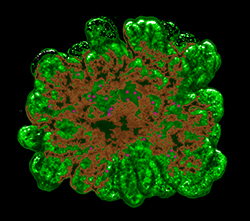 |
| Stem cells grow outward in a 3D structure resembling a miniature pancreas.--Courtesy of the University of Copenhagen |
With diabetes at epidemic levels in the U.S., and worldwide rates growing ever higher, new and improved insulin delivery methods are constantly in vogue. Devices like the artificial pancreas, insulin pills, inhaled treatments--all of these have some iteration with clinical results to show. And researchers are now in the very early stages of creating a true miniature pancreas from stem cells.
Scientists at the Danish Stem Cell Centre have shown that they can "grow" mouse pancreatic cells into expanded, branched structures in a 3D culture. In the long term, this could have implications for building a human pancreas, which, although currently envisioned as a drug-testing tool, could also lead to insulin-producing mini-organs built from stem cells, according to a report from the University of Copenhagen.
In work published in the journal Development, the team studied first and foremost how these cells proliferate on their own. The scientists noted in particular the development potential of pancreas cells, demonstrating that cells in a cluster have a community effect that allows them to expand more efficiently than individual cells. Down the road, this information could lead to a more fully developed method of creating beta cells, which produce the insulin-releasing characteristic of a healthy pancreas, according to the abstract.
"Under optimal conditions, the initial clusters of a few cells have proliferated into 40,000 cells within a week," said lead researcher Anne Grapin-Botton in a statement. "After growing a lot, they transform into cells that make either digestive enzymes or hormones like insulin and they self-organize into branched pancreatic organoids that are amazingly similar to the pancreas."
Other methods of insulin delivery in the very early stages have hinted at the future possibility for a "smart" pancreatic replacement, such as injected nanoparticles that release insulin when blood glucose reaches a certain level. This and the possibility of a stem-cell-grown pancreas are potential game-changers down the road and show just how far diabetes research has come already.
"We think this is an important step towards the production of cells for diabetes therapy, both to produce mini-organs for drug testing and insulin-producing cells as spare parts," said Grapin-Botton. "We show that the pancreas cells care not only about how you feed them but need to be grown in the right physical environment."
- here's the University of Copenhagen report
- and here's the Development abstract